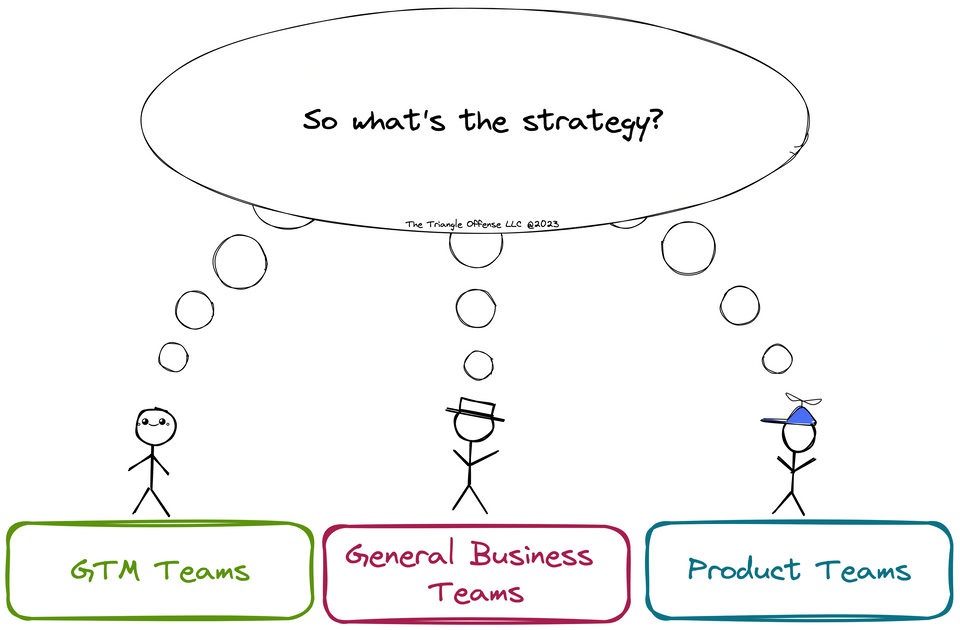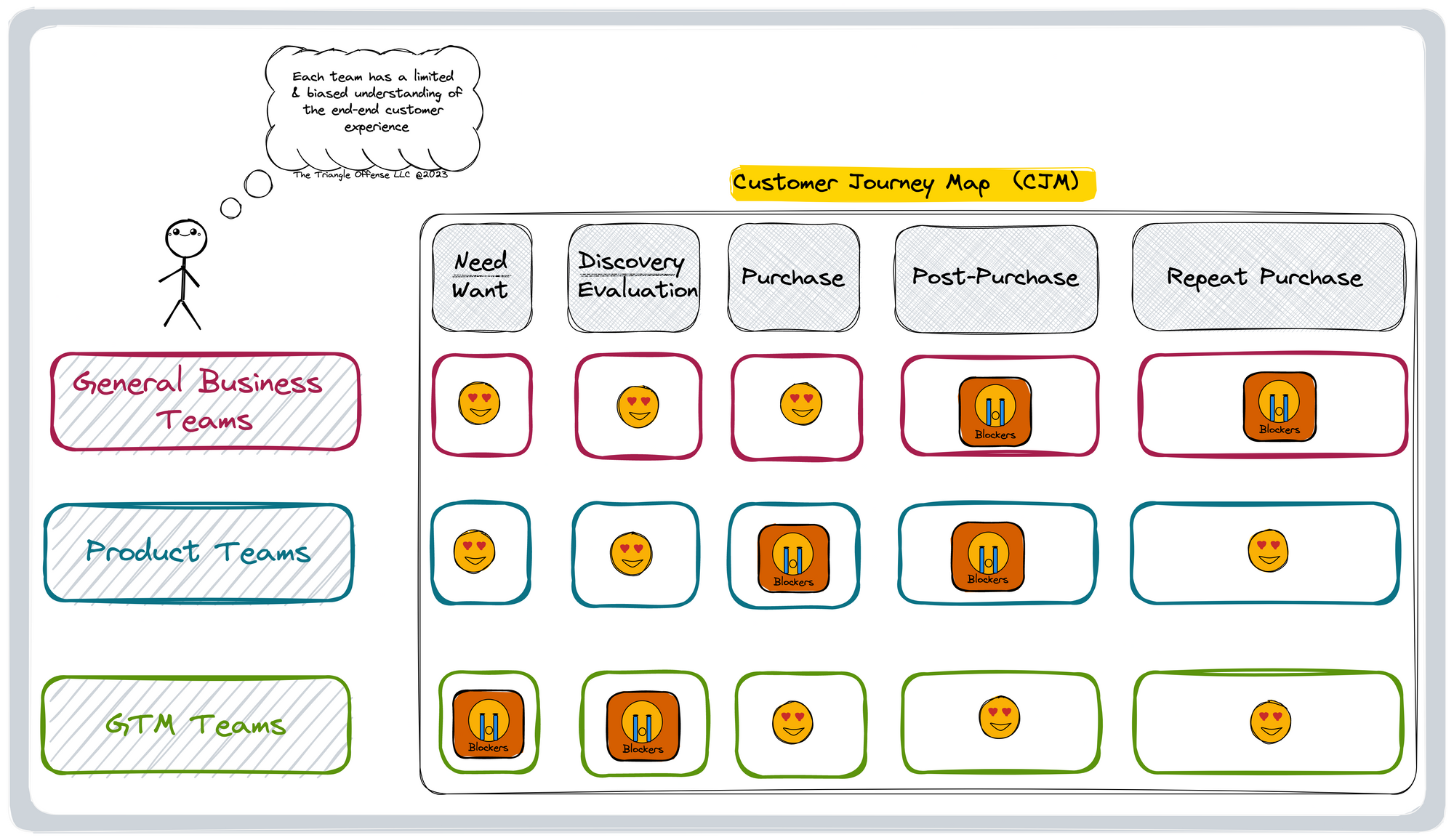CX Documents of the Triangle Offense Framework (Part One)
Without proper CX documentation, you cannot execute an effective and efficient VOC data-gathering process.

Missing and Ineffective CX Documentation Limits Your VOC Data-Gathering Process
In an earlier post, I wrote about the problems afflicting CX strategy creation and execution. In that post, I pointed out that one of the main issues organizations need to address is the need for robust CX documentation.
In part one of the CX documentation series, I want to highlight the barriers you may encounter in your organization and how they contribute to ineffective—and sometimes missing—CX documentation.
Let's dive into part one.
You cannot execute an effective and efficient voice-of-the-customer (VOC) data-gathering process without proper CX documentation. As a CX practitioner, the business for which you work may find itself in one of the following scenarios:
- They lack a good understanding of their customers’ end-to-end experience.
- Their siloed organizational design limits shared understanding of customers’ end-to-end experience across the general business, product, and GTM teams.
- They have limited resources for mapping and understanding customers’ end-to-end experience.

Without an end-to-end VOC data-gathering process, how can your organization figure out how to successfully quantify opportunities to improve the customer experience?
In other words: How can you determine what opportunity you should invest in? How can you quantify, using economic data, why your organization should invest in that opportunity?
However, many organizational barriers stop a VOC data-gathering process from capturing the required end-to-end customer experience. Let's take a look at some of the obstacles present in many business organizations today.
Culture of Me, Not Thee
As a CX practitioner, you may have stepped into a new role on a team and feel eager to share fresh opportunities to improve the customer experience with other teammates and teams. But you may find that when you present new customer information, very few people are interested in learning about the latest customer problems you've uncovered.
This attitude is a reflection of an inward-focused culture. Some organizations say they are customer-focused; however, upon closer inspection, they have already decided who their customer is. They create an idea or, worse, fixate on a persona within a customer segment. Over time, they become comfortable working within the construct of what they believe to be their customers’ "right problems."
Once organizations and teams formulate a fixed belief about their customers, the value of CX documents plummets because everything is "known," which means creating detailed CX documentation that helps with the data-gathering aspect of the VOC process, which holds very little value for those organizations. Why? Because they think they already know what most of their problems are, so they feel confident about the next steps vis-à-vis fixing the customer experience.
Short-Term Planning Hamster Wheel
Let's take a quick quiz. On a scale of one to ten, how stressful is your quarterly planning (QP)? How much of a time suck has QP become in your organization? How much flexibility is built into the QP based on the strategy the executive team has laid out?
Why bother understanding the end-to-end customer experience when teams are tasked to avoid net-new opportunities in favor of optimization work.
Can your QP accommodate new business opportunities identified through the VOC process? Or is your QP process so fragile that a slight wind may push the teams off course? Or, what if the work moves away from optimization to net-new opportunity work that requires more than a quarter to complete?
Short-term QP is a barrier to creating the required CX documentation because the teams never look beyond optimization opportunities and are entrenched in specific stages in the customer journey.
Ineffective Customer Research
Tell me if you've heard these statements before:
- We don't have funding allocated for researchers right now. We need to hire [X] first; then, maybe we'll consider funding for researchers.
- The research findings are not what I thought they would be. They don’t match my view of the problems the customers experience with our products and services.
- I don’t see the ROI from the research we've conducted in the past because most of the findings were already known, so we wasted a lot of time in the process.
Here's the thing: All these statements have a kernel of truth. However, suppose the customer research your organization is conducting isn’t helping the VOC data-gathering process. In that case, you have to reassess how your organization is implementing its strategic research program and on-demand research efforts.
In its simplest form, research is extracting information from customers and is essential in the VOC process’s data-gathering aspect. Good CX documentation requires customer research. When customer research is not effectively implemented, it will hurt your VOC process and compound the problem of inaccurate customer data over time.
Opinions & Experience Trump Qualitative and Quantitive Data
When customer data is lacking across an organization, planning meetings morph into opinion fests. These types of planning meetings are incredibly high-risk for business organizations.
The executive team requires CX leaders to present new opportunities for improving the customer experience backed by economic data so they can make the case to the finance department. The finance department typically operates from the known costs vs. unknown return perspective. Therefore, you must present a qualitative plus quantitative opportunity package with accurate economic data.
When individual opinions and "I have 15 years of experience" statements start getting thrown around in meetings, the wheels quickly fall off the wagon. That’s when opinions and experience statements trump customer data, and you find an outdated VOC data-gathering process with withered CX documentation that is ineffective and insufficient for strategic planning meetings.
Tacticool Product Development

With the adoption of agile software development methodologies such as Scrum, Extreme Programming, Kanban, Lean Software Development, and Scaled Scrum, many organizations are entirely too execution-focused. Many organizations have gone all in on these tactical methodologies and have made them the focal point of how teams should work.
One of the tactical methodologies’ outputs is gathering product feedback, and as a result, many product teams focus only on their product in a customer experience. When a customer has input, it becomes a backlog item that requires quarterly review, and product teams tend to drift toward a tactical improvements bias over time. (This becomes apparent in QP.)
With so many teams focused on tactical product execution, it’s easy for them to focus only on the customer journey stage where their product lives and forget the opportunities generated across the end-to-end customer experience.
Summary
The barriers I've presented here are by no means the only ones that contribute to an organization’s missing or ineffective CX documentation. Many more obstacles can impact a CX practitioner’s work and the CX documents they may want to build and use in the VOC data-gathering process.
But here’s the good news: Although these barriers can slow you down as a CX practitioner, they don’t have to stop you from building the CX documentation you need to improve your business’s customer experience.
In part two of this series, we’ll look at the CX documentation with which every CX practitioner should be familiar and explore why it’s important and how it will help you in your VOC data-gathering processes.
Written by Leo Vroegindewey, B2B CX Consultant
Get in touch to improve your customer experience and increase sales. Let's talk about how I can help your business grow. Email me.